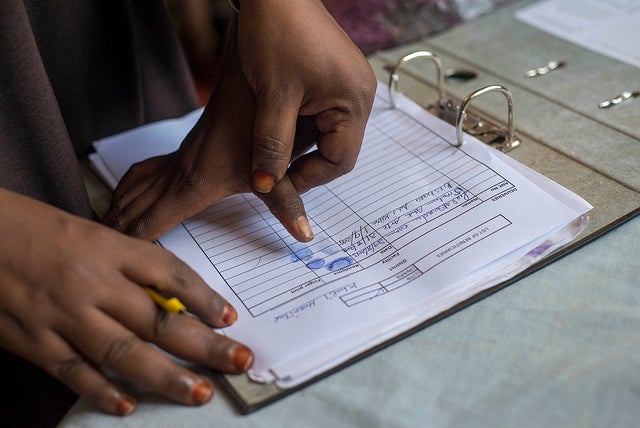“Hello, is anyone home?” asks a young woman from outside a home in Dire Dawa, wearing a T-shirt identifying her as part of the team from Ethiopia’s demographic health survey (DHS). A young mother inside responds, picking up her baby as she heads to the doorway.
“My name is Samira and I am here as part of a survey team. Do you have time today to answer some questions?” So begins the detailed process of assessing which health services the young mother and her children have received in the previous years – to establish coverage estimates for the region and nation.
It is estimated that of the annual 3 million newborn deaths, 2.6 million stillbirths[1] and 292,000 maternal deaths[2], a substantial proportion could be averted through use of a limited number of high-impact, evidence-based interventions. Household surveys regularly conducted around the world attempt to capture key maternal and newborn health data on recent births such as place of delivery, who attended the delivery, birth weight, care received in the postnatal period and the nature of any complications during pregnancy.

Challenges loom with capturing data on coverage of interventions, which often relies on recall of events and services that took place months, even years, prior. National governments and health programs have relied on coverage measurement to assess progress in achieving target outcomes, through a combination of household surveys, real-time observations at the facility level and increasingly through routine information systems. If meaningful progress is to be made towards reducing maternal and neonatal deaths and stillbirths, the role of effective coverage measurement is critical to gauge global and national progress.
The importance of coverage measurement is established, building upon over a decade of bedrock work of the Countdown to 2015 project. The Countdown to 2015 final report was released yesterday, tracking progress in 75 countries against maternal and child health goals. More specific measurement of coverage of life-saving interventions, especially clinical services, requires further innovation.
A measurement improvement agenda supporting the Every Newborn Action Plan (ENAP) was released in September, outlining bold development of some of the toughest metrics in the most challenging contexts. The Canadian government announced investment in improved tools for data collection. Last month, the Primary Healthcare Performance Initiative was launched to ensure tracking of critical health systems indicators. Last week, The Lancet published a comment submitted on behalf of a collective of over 20 global MNCH experts who met in May in Kirkland, Washington, calling for sustained and improved measurement of maternal, newborn and child health interventions in the context of the new Sustainable Development Goals (SDG). This comment proposes five key principles to improve measurement and data use in the MNCH community: focus, relevance, innovation, equity and leadership.
How does it all fit together? Fortunately, measurement experts involved in all of these efforts are talking – sharing plans and coordinating efforts closely. This week in Mexico City, global partners have come together for the first-ever jointly-coordinated Global Maternal Newborn Health Conference. This serves as a critical forum for the global community to translate the new SDG health goal and promote sound accountability, measurement and learning. A plenary on October 21st at 9:00 am will highlight global coordination efforts and share perspectives from field implementation; other sessions will shed light on innovations and challenges.
In the work going forward, two key principles for improving measurement deserve further focus: relevance and innovation. Coverage data should be relevant – of primary value in and for the country in which the data are collected. We must answer: Who are the users? How will they use the data? What can be learned? What training and support is required? Equally important, how can data collection be improved to reduce recall biases and enable more rapid, timely recording and reporting of services and quality in facilities? Innovation can result in greater relevance. Practitioners and decision-makers should be supported to improve data availability while harnessing technology to avoid over-burdening systems. Data officers must also be supported – building their leadership and analytical skills. Countries can take the lead in prioritizing which decisions they face and which data they need at each level of the system.
There are already ambitious examples of innovation for relevance. New measures outlined in ENAP’s measurement improvement roadmap will be field-tested shortly. A set of maternal health indicators has been prioritized by experts in the Ending Preventable Maternal Mortality (EPMM) group (report available soon). Prioritization of quality of care metrics is underway – to improve specificity and utility. Donors are in frequent contact to share plans and ensure momentum. In June, partners endorsed a Call to Action to advance a broader agenda for post-2015 measurement in the health sector. There is also a resounding call for WHO to launch a monitoring and evaluation reference group for maternal/newborn health – to set guidelines and norms for the world.
We’re optimistic. Are you? How can your organizations engage and join in this momentum – to measure what matters to save lives of mothers and newborns more effectively on the ground? What are your best ideas to increase relevance of data through innovation?
Lara Vaz: Lara is the Senior Advisor for Monitoring and Evaluation in the Department of Global Health at Save the Children- US.
John Grove: John is a Senior Program Officer in the foundation’s MNCH team where he leads our strategy measurement and global evidence portfolio. Follow him on Twitter @GroveJohn
Photo: “DSC_4735” © 2013 A.Gichigi/Trócaire, used under a Creative Commons Attribution license: http://creativecommons.org/licenses/by/2.0/
[1] UNICEF, WHO, The World Bank, United Nations Population Division. The Inter-agency Group for Child Mortality Estimation (UN IGME). Levels and Trends in Child Mortality. Report 2013. New York, USA, UNICEF, 2013
[2] WHO. WHO Media Centre Maternal Mortality. Fact Sheet Number 348. Geneva, Switzerland, 2014


